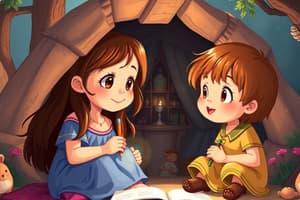Podcast
Questions and Answers
What is the primary purpose of concept books for children aged 2-4?
What is the primary purpose of concept books for children aged 2-4?
- To improve children's arts and crafts skills
- To entertain children with stories
- To teach concepts such as opposites and seasons (correct)
- To prepare children for formal education
Which skill is NOT promoted by wordless picture books?
Which skill is NOT promoted by wordless picture books?
- Verbal skills
- Sequencing
- Comprehension
- Problem-solving (correct)
Why are illustrations important in picture books?
Why are illustrations important in picture books?
- They help express emotions without text (correct)
- They need to be less detailed for young readers
- They provide content for the author
- They add color without contributing to the story
Which of the following is NOT a benefit of using wordless picture books?
Which of the following is NOT a benefit of using wordless picture books?
What does 'high literary merit' refer to in picture book selection?
What does 'high literary merit' refer to in picture book selection?
Which criterion is crucial for selecting a children's picture book?
Which criterion is crucial for selecting a children's picture book?
What is an effective characteristic of a great title for a picture book?
What is an effective characteristic of a great title for a picture book?
How should illustrations in picture books behave regarding stereotyping?
How should illustrations in picture books behave regarding stereotyping?
What is a defining characteristic of a picture book?
What is a defining characteristic of a picture book?
What is typically found on every page of a picture book?
What is typically found on every page of a picture book?
What age group is primarily targeted by alphabet picture books?
What age group is primarily targeted by alphabet picture books?
What purpose do counting picture books serve for children?
What purpose do counting picture books serve for children?
What is a potential benefit of picture books with no words?
What is a potential benefit of picture books with no words?
Which of the following is NOT a characteristic of counting picture books?
Which of the following is NOT a characteristic of counting picture books?
Why are pictures in picture books sometimes more important than the words?
Why are pictures in picture books sometimes more important than the words?
What is a common misconception about the length of picture books?
What is a common misconception about the length of picture books?
Flashcards are hidden until you start studying
Study Notes
Overview of Picture Books
- Picture books for children emphasize illustrations as vital storytelling elements, often considered as important as or more significant than the text.
- Traditional length is 32 pages; variations exist, like Little Golden Books which are 24 pages.
- Illustrations are present on nearly every page, sometimes conveying the story without any words.
- They can be used as read-alouds or for guided individual reading by children.
Types of Picture Books
-
Alphabet Books
- Suitable for a wide age range, presenting letters thematically (e.g., animals, foods).
- Intended primarily for pre-readers and beginning readers, but may appeal to older audiences through complex content.
-
Counting Books
- Introduce numerals and corresponding words, helping children understand basic math concepts and one-to-one correspondence.
- Advanced counting books tackle concepts like addition, subtraction, and multiplication for older children.
-
Concept Books
- Target children aged 2-4 and explain specific ideas, objects, or activities.
- Teach foundational concepts such as opposites, shapes, and seasons.
-
Wordless Books
- Dismissed by some as simplistic, yet they are powerful for enhancing literacy skills.
- Encourage comprehension, vocabulary building, and understanding of story structure through illustrations alone.
Benefits of Wordless Picture Books
- Develop comprehension skills by requiring interpretation of visuals.
- Foster confidence and independence in young readers.
- Promote verbal skills and discussions regarding the story.
- Support vocabulary acquisition through illustration interpretation.
- Inspire visual appreciation and engagement with art.
- Enhance understanding of story structure and sequence.
- Encourage writing skills through narrative creation based on images.
Criteria for Selecting Picture Books
- Selecting the right book involves matching the content to the child's interests and developmental stage.
- Look for books with high literary merit that engage the child.
- Ensure illustrations accurately reflect the plot, characters, and setting, while avoiding stereotypes.
- Text length and complexity should align with the child's age or developmental level.
- Seek books that offer substantial engagement for both readers and listeners.
- Use trusted recommendations from professionals in literature.
Essential Elements of Picture Books
- Title
- Should be memorable, intriguing, and reflective of the story's tone.
- Employ rhyme or alliteration, highlight themes, or incorporate main character names for appeal.
Studying That Suits You
Use AI to generate personalized quizzes and flashcards to suit your learning preferences.




